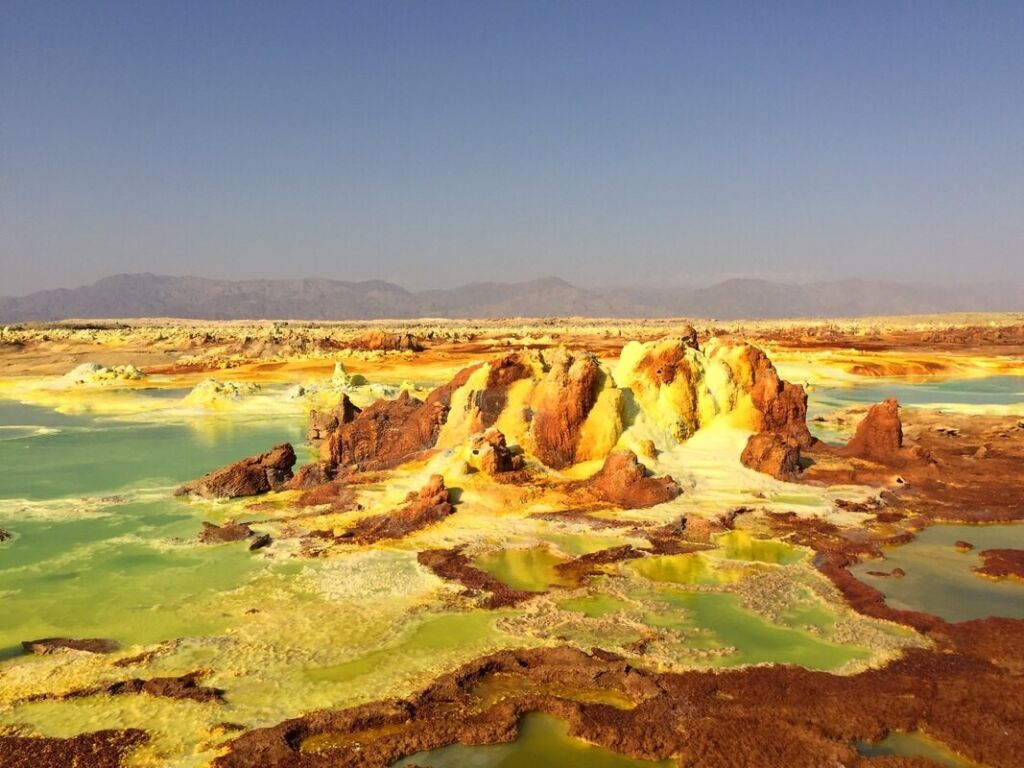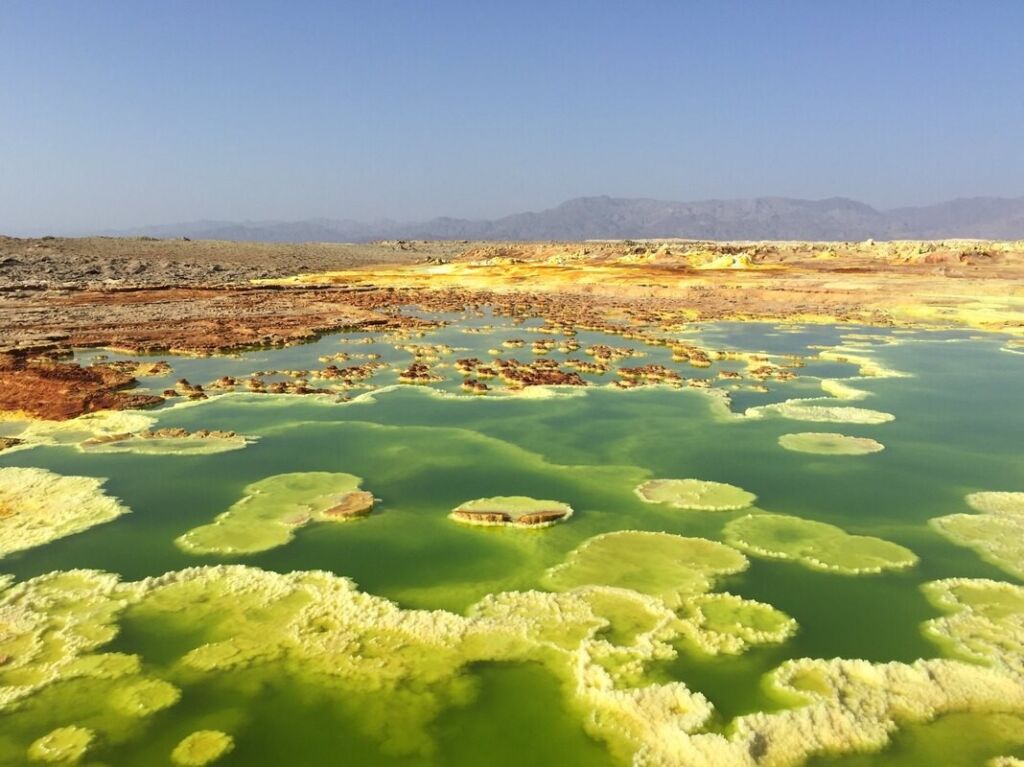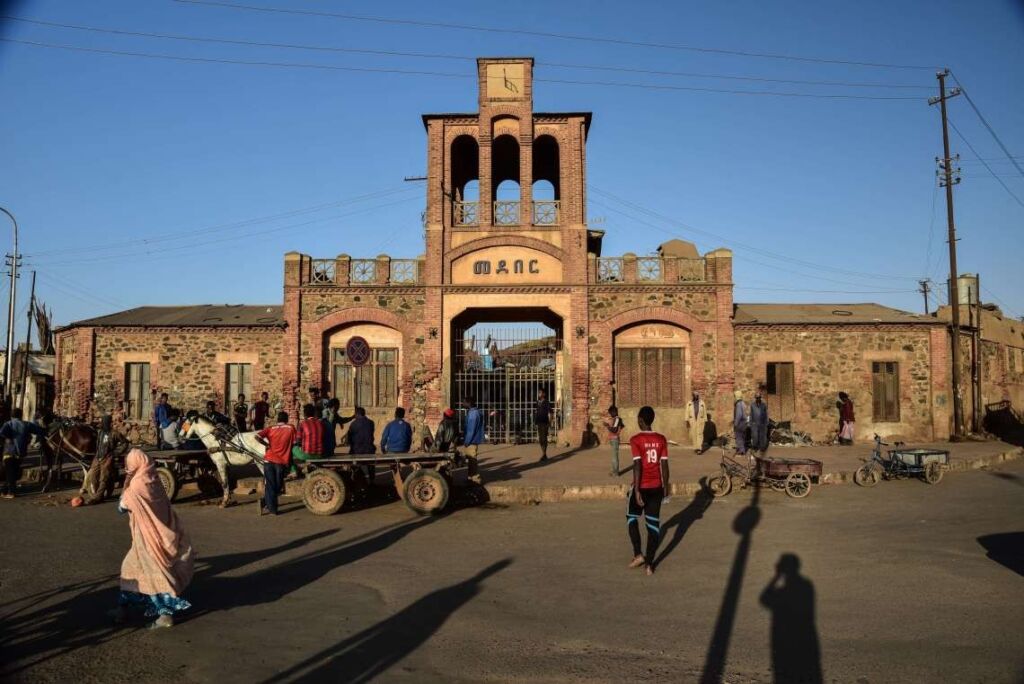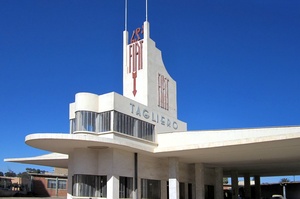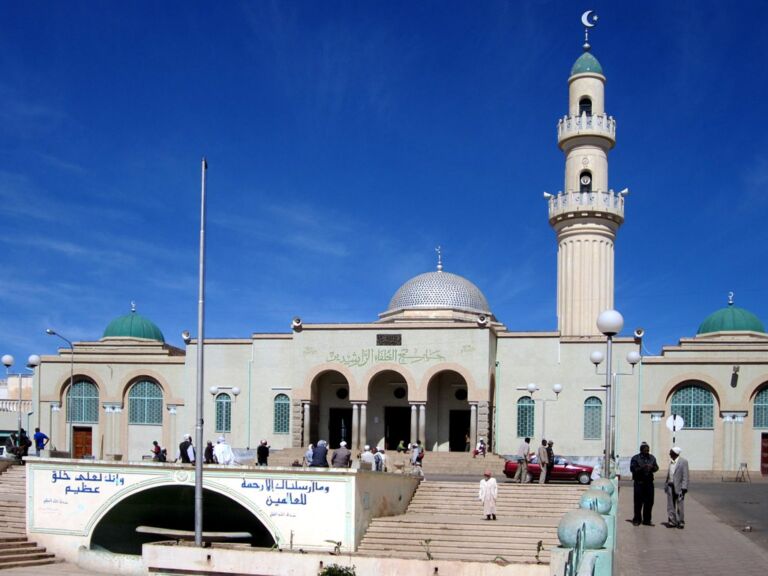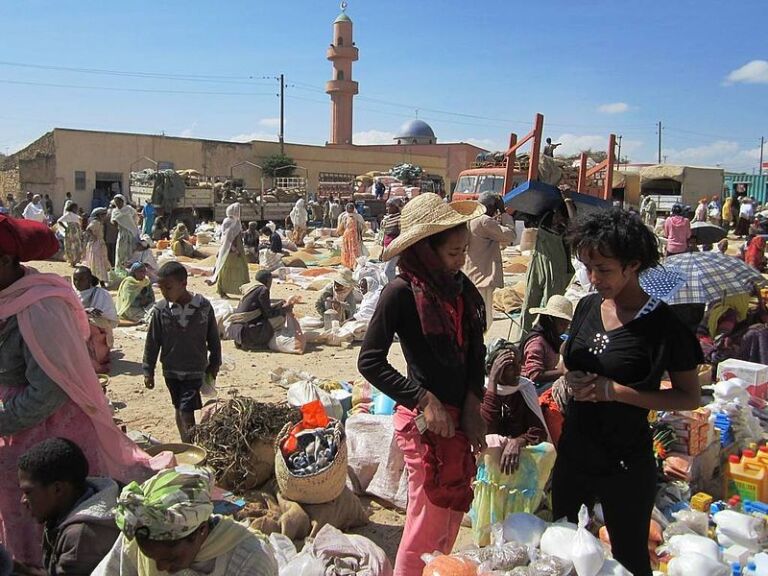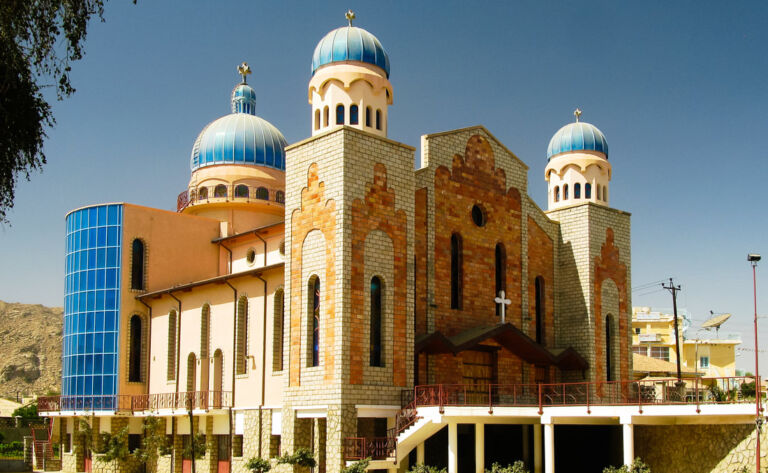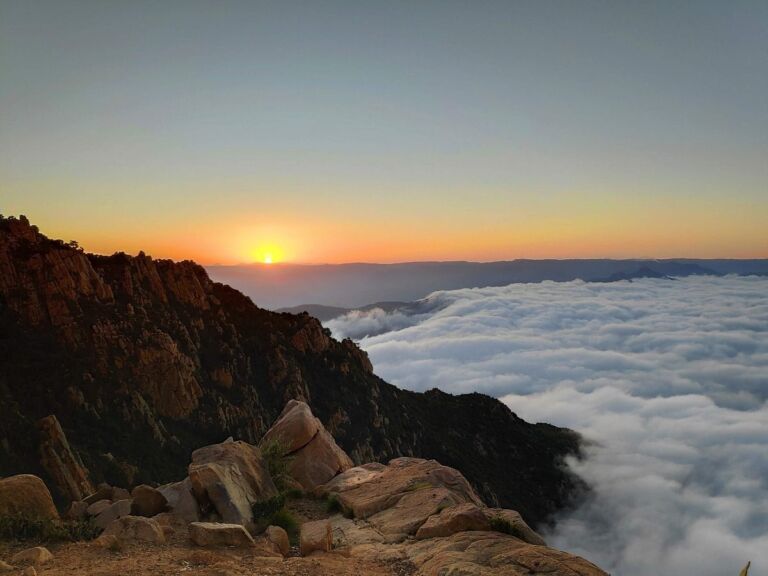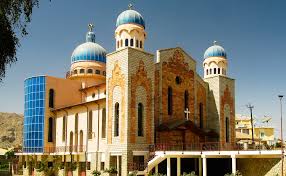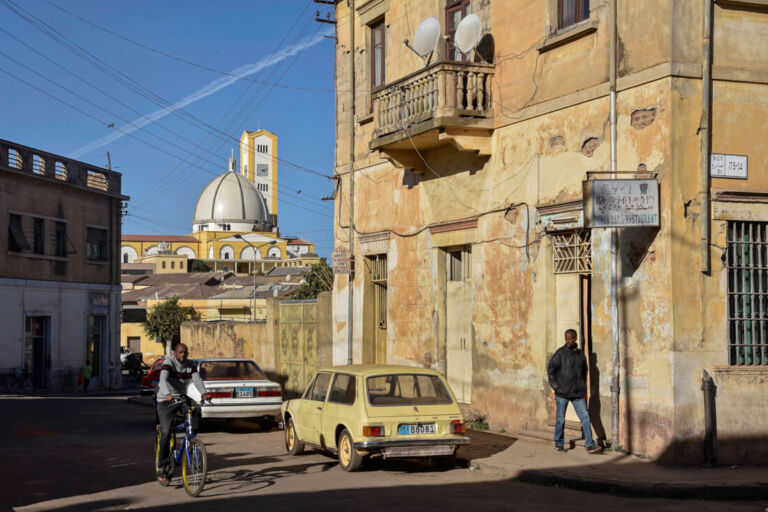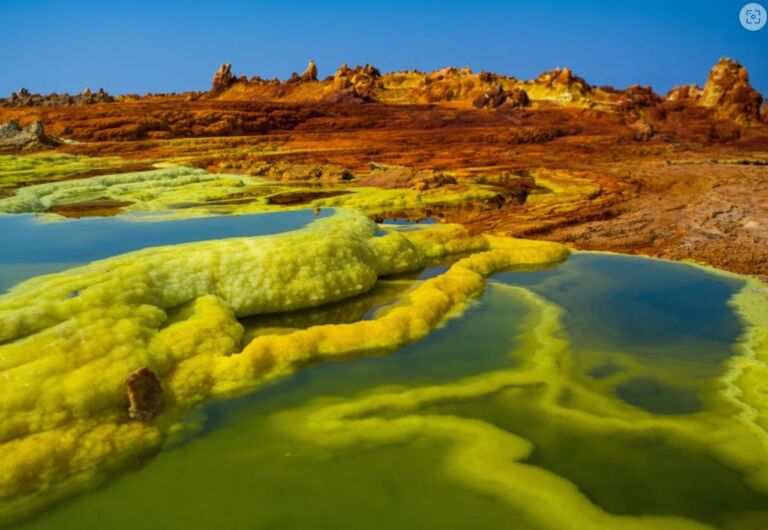Note, that it’s not possible for women to visit the monastery. We can change this day trip with any day trip from our website. The price will stay roughly the same.
Day 1: Arrival in Asmara and transport to your hotel.
Day 2: Today we’ll have a full day in the capital with a strong focus on the modernist, fascist and art deco architecture the Italian occupiers left behind. If it’s your first time in Asmara you’ll be amazed by the peaceful, friendly atmosphere, the clean streets, perfectly conserved buildings, amazing Italian architecture, the great food and the best coffee there is. Coming to Africa’s ‘Little Rome’ as it was called by the Italian occupiers back in the day, will make you feel like you’re on a film set. Don’t forget to bring your camera, because you’re going to have tons of photo opportunities!
The main attraction in Asmara is of course the World Heritage listed colonial Italian architecture which can be found all over the city. When the Italians were still around, they got obsessed with constructing buildings and building a little Italy in Africa. The city was well-planned and has palm-lined streets and beautiful examples of modernist, fascist and art deco architecture. The center is full of cafés, bars, shops and old cinemas with plenty of photographic opportunities.
We will start our day in our favorite coffee bar in town, where we’ll brief you on the upcoming day's activities while drinking a yummy macchiato. We’ll then head out to see the historical center, cover as much as we can and we’ll also bring a visit to the National Museum, which will be handy for our stops later on this travel. At noon we can show you one of the many excellent restaurants Asmara has to offer. Maybe you’d like to try some local food or maybe you’re in the mood for some Italian dish?
After your tour, you’ll be brought back to your hotel in Asmara, and you’ll spend the evening in the capital.
Day 3: Today we’ll go to Debre Bizen, an Orthodox Tewahedo Church monastery located at the top of the Debre Bizen Mountain near Nefasit. It has an important library with many Ge’ez manuscripts. The monastery was founded in the 1350s and was damaged during Ottoman rule in the sixteenth century.
The monastery is beautifully located like a crow’s nest way up high on the top of the mountain. The only way to get there is a two-hour journey with a rewarding spectacular view of the area once you’re on top. We’ll start our day after breakfast, driving to the town of Nefasit, about 25 km down the hair-pin bends of the Asmara- Massawa road. The monastery is the symbol of Christianity in Eritrea, where many saints and explorers have been buried. It will take us up to 3 to 4 hours to go all the way up, depending on your physical condition. We ask you to bring plenty of water (at least 3 liter), lunch, fast sugars, energy bars and fruits such as bananas.
Once we’ve reached our destination you’ll be amazed by the spectacular views and you’ll have the chance to have a tour around the monastery which consists of pink granite buildings cut into the sides of huge rocks. We find African olives growing in the monastery which look very similar to the European ones. We’ll also visit the modern part and the museum, home to over a thousand ancient manuscripts and other artifacts.
The monks live in an egalitarian society and live from what they cultivate and drink the rainwater they collect. They dedicate their lives to teaching and preaching of love and brotherhood. Anyone coming to the monastery is welcome to receive shelter, food and clothes. The monks will be happy to show you around and tell you everything about the monastery and themselves.
The best views are of course at sunset, but given that we cannot walk in the dark, we need to go back in time. It is possible to stay at the monastery overnight, but we don’t want to abuse the hospitality of the monks and use their place as a hotel for tourists. We make sure we don’t run too many tours over there and leave gaps in between our visits. Please, ask us if it’s possible to visit during your time of travel.
Even though you’ll miss sunset, the views of the sea and Dahlak Islands and the southern mountains are the most impressive in Eritrea. After our stay, we’ll go back down, which is another 2 hour walk and then head to Dekemhare in the late afternoon.
This tour is only for men as women are not allowed in the monastery. Make sure you are fit to do this tour, apply sunscreen, wear sunglasses and a hat and bring enough water and food. Remember that you’ll be going to a holy site. If you wear shorts and sandals or inappropriate clothing we might deny you joining our tour. Be sure to wear adequate shoes and good socks.
Day 4: Today we’ll be driving to Adi Keyh, from where we’ll go to the archeological site of Kohaito (also spelled Qohaito), about 121 km south of Asmara, where once was the ancient thriving town of Koloe, which was an important city during the Aksumite Kingdom. The site is enormous and there are large remains to be seen. The area measures 2.5 km by 15 km and only 20 percent of the ruins have been dug up. Highlights are the columns and left overs of the Temple of Mariam Wakiro, surrounded by several other temple remainders and also a tomb made out of sandstone. We’ll complete our visit by a hike to the edge of the canyon which offers fantastic views over the area. We’ll also visit several rock-art sites all within the same area. A Iago, we’ll also visit a place which is covered in rock paintings dating from around 4.000 - 5.000 BC. There are over 100 figures painted: cattle, antelopes and lions. At the sites of Ba’atti, Abager, Zebanona and others we can observe figures of warriors with spears and shields. Overnight in Adi Khey.
Day 5: South of Kohaito we can find Metera (= Matara), which was a town 600 BC. It’s a huge site full of ruins and the second largest site after Adulis. One of the most important features is the enigmatic stele, with pre-Christian symbols. The stele is about 2.5 m tall and faces to the east. Several golden objects have been found in Metera which have all been moved as well as household items and other tools. As only a small part of Metera has been excavated, there are still many things to be discovered. We’ll drive to Asmara, where we'll stay overnight.
Day 6: Keren (Cheren) is the second largest city in Eritrea after Asmara. It is located around 91 kilometers north of the capital and is situated 1.390 meters above sea-level, surrounded by mountains. It is home to the Bilen, Tigre and Tigrinya people. Once an important commercial hub it suffered a lot of damage during World War II and the Eritrean-Ethiopian war. There are many points of interest in the city such as the Tigu Fort built in the 19th century by the Egyptians, the St Maryam chapel located in a baobab, the old Italian and British army cemeteries, the old mosque, the old train station and much more.
We’ll cover as much of the city as possible so you’ll see the most important places and get a good feel of what this city is all about We’ll have a look at the market as well and on Mondays there is a live stock market with sheep, cows, camels, donkeys and chickens being sold. At noon we’ll make sure you’ll have a good local meal as well. Overnight in Keren.
Day 7: Today we’ll drive towards the port city of Massawa, about 2 meters above sea level on two islands (Massawa and Taulud) off the coast and on the mainland. The historic center of Massawa is located on the outermost of these two islands, a 1000 m long, 300 m wide coral island. This island is connected by a 440 m long dam to the second island of Taulud, which was uninhabited until the 19th century. Taulud in turn is connected to the mainland by a 1030 m long second dam.
Massawa has a warm desert climate with extremely high humidity in summer, but little rainfall, averaging about 180mm of precipitation per year. It is very warm day and night all year round. The average annual temperature approaches 30°C and is one of the highest in the world. The relative humidity is very high due to the combination of desert heat and moisture from the Red Sea. Massawa is one of the hottest cities on the planet, so it’s important to plan your visit well and avoid the hottest period.
Massawa was originally a small seaside town about 50 km north of the port of Adulis in an area that in ancient times coincided with the Kingdom of Aksum. After the fall of Axum in the 8th century, Massawa was occupied from 740 to the 14th century by the Beja, (Beja Kingdom of Eritrea), but Massawa, which lay between the sultanates of Dahlak, Qata and Baqulin, fell from time to time among other Eritrean kingdoms (the Balaw Kingdom, (12th-15th century) and the Midri-Bahri Kingdom (14th-19th century)). Under the Balaw Kingdom, the oldest mosque in Eritrea, the Sheikh Hanafi Mosque, was built on Massawa Island.
In the 15th century Venetian traders lived in Massawa, which was then important as a port for the Arab slave trade for slaves from other countries in Asia and Africa.
From 1557 to 1846 century, Massawa almost fell under the Ottoman Empire. The former Balaw kings had expressed their desire to rule part of the area as "Na'ib" to the Sultan. In 1846, Massawa was almost handed over to the Egyptians and therefore did not become part of the Kedivate of Egypt. After the Ethiopian-Egyptian War of 1876, the British occupied the Kediva in 1882, who handed over the city to Italy in 1885. From 1890 to 1936 it was the capital of the Italian colony of Eritrea.
Because of the different colonisers the city has known, we find Portuguese, Arab, British, Italian and Turkish remnants in the City of Islands. The city used to be a cultural hub which drew artists and intellectuals and was once the most important city under the Italian rulers who connected Massawa to Asmara by railroad. We still find a lot of Ottoman influences in the city, especially on the architecture as well as several buildings and structures which were developed by their successors, the Egyptians and finally a lot of beautiful Italian houses.
The most interesting buildings are the Imperial Palace, the Cathedral, the Banco d’Italia, the Shrine of Sahaba, the Sheikh Hanafi Mosque, the coral houses in the old town, the bazaar and the Ottoman buildings.
Today we’ll leave early in the morning and we’ll be in Massawa all day long showing you around the old town, the most notable buildings as well as the coastline. We’ll also show you a good place to have lunch. We’ll overnight in Massawa
Day 8: Today we’ll head out early in the morning to discover the sites of Adulis, the ancient port of Zula and the village of Foro.
Adulis is a historic town and archaeological site in the Semenawi Keyih Bahri region of Eritrea, approximately 45 km south of Massawa. It was a port city of the Kingdom of Aksum on the coast of the Red Sea. Adulis was on the trade routes with Greece and the Byzantine Empire. In ancient Egypt, Adulis was probably a place in the mythical Land of Punt. The Periplus of the Erythrean Sea mentions Adulis, and describes the place as a trading place for, among other things, ivory and slaves. In the 2nd and 3rd century AD. the city was frequented by Roman traders.
A work from the 4th century mentions a journey of an Egyptian jurist to India. He is said to have been accompanied on part of his journey by one Moses, Bishop of Adulis. The Byzantine Kosmas Indikopleustes mentioned two inscriptions he had found in Adulis in the 6th century. One inscription told of the war elephants that Ptolemy III Euergetes I had taken from this region. The other inscription - called Monumentum Adulitanum - told of the victories that a king of Aksum, possibly Sembrouthes, had won in Arabia and northern Ethiopia.
Thanks to Adulis, Aksum had control of the Red Sea. The port was built around 525 AD. was used as a base to invade the kingdom of Himyar. In the end, little more was heard of Adulis. Attacks from Aksum on the Arabian coast would continue until 702. Adulis is said to have been occupied by muslims, who thereby put an end to Aksum's access to the sea. This would isolate Aksum from the Byzantine Empire and other allies. The city is also occasionally mentioned by muslim writers. In any case, it seems that Adulis fell into disrepair from the 7th century onwards.
Adulis was one of the first sites in ancient Aksum to be excavated. A French team conducted an initial survey in 1840, and in 1868 staff of British officer Robert Napier excavated several buildings, including the foundations of a possibly Byzantine church. The first scientific excavations took place in 1906 by a German expedition led by R. Sundström. He uncovered a large building in the north of Adulis that he labeled a palace. Aksum coins were also found. The research results were published in 1913.
The Italian Roberto Paribeni discovered a few other buildings in 1907, including houses. Pots were also found, such as imported amphorae from Aqaba.It then took about 50 years before the next series of excavations took place. In 1961 and 1962, Ethiopia sent an expedition led by Francis Anfray to Adulis. In addition to material indicating a strong link between Adulis and Aksum, a layer indicating a destruction of the city was also found.In the deepest layers, glass artifacts that closely resemble specimens from Egypt's 18th dynasty have been found. A bottle has also been found that must have come from Abu Mena and must have been taken to Adulis by a pilgrim. Eritrea gained independence from Ethiopia in 1991. Efforts have been made from Eritrea to recover the archaeological finds residing in Ethiopia.
After our tour in Adulis, we’ll head to Zula, a small town on the Red Sea coast and four kilometer away from Adulis. Zula is a port where the Aligede River and the Red Sea connect and close to mangroves. An international team of researchers discovered a paleolithic site with stone and obsidian tools of over 125.000 years old near the Bay of Zula.
Our tour starts early in the morning coming from Massawa. We ask you to bring a packed lunch and enough water. Please bring sunscreen, sunglasses and a hat to protect yourself against the sun. We’ll overnight in the area of Zula.
Day 9: Called the gateway of hell, the Danakil Depression is one of the hottest places in the world and stretches from the north of Ethiopia all the way into the south-east of Eritrea. It’s an alien landscape full of hot springs, acid pools and salt mountains. It’s a weird mixture of green, yellow, orange and white colors all dancing in front of your eyes and home to volcanic lakes. The area was once part of the Red Sea and because of the many volcanic eruptions, there eventually was enough lava to seal the area off, creating this abstract bizarre landscape. Daily temperatures are around 34°, but can rise up to 50° and the area hardly gets any rain. It’s truly one of the biggest natural wonders in Africa, and coming here makes you feel like you’re on another planet. It’s a great addition to your trip to Eritrea and will give you the opportunity to take some really unique pictures. Needless to say you need to bring tons of water and protect yourself well against the sun.
Living in the middle of this strange place made of lava and salt are the Afar, who are mostly nomads: herding goats and camels or the ones who are in more fertile places cattle. The Afar who live near the coast are fishermen and also salt miners, which they use to trade with products from the inland. They live in light huts which are easily transported by camels so they can easily move around.
We’ll explore the Buri Peninsula, composed of lava flows and granite. It’s about 50 km long and 35 km wide with volcanic hills and a large salt-water lagoon in the middle, but there are mangroves and salt pans as well. We can find ostriches, baboons, gazelles, jackals and wild asses if we’re lucky. We’ll stay in Ghela’elo tonight..
Day 10: We’ll drive back to Massawa stopping near the Wongobo crater to get the maximum out of our trip and we’ll arrive in the late afternoon. Overnight in Massawa
Day 11: We’ll drive back to Asmara. End of tour.
Includes:
- Transport to all places in the itinerary.
- All activities and entrance fees
- Accommodation for 5 nights
- Professional local guide: English or Italian
Doesn’t include:
- Meals and drinks


